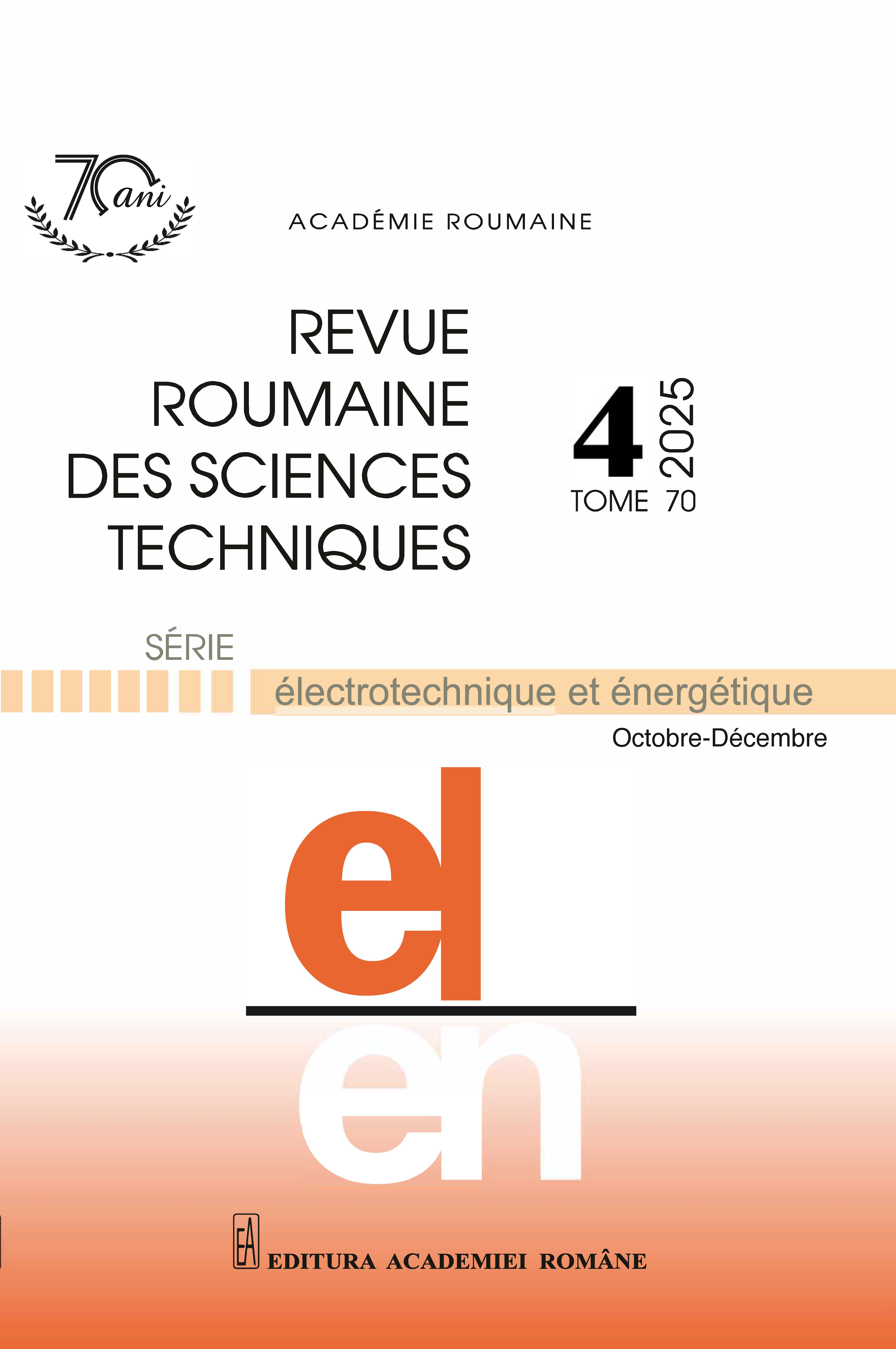A GENERALIZED MULTISOURCE SYMMETRICAL MULTILEVEL INVERTER WITH REDUCED SWITCHES
DOI:
https://doi.org/10.59277/RRST-EE.2025.4.17Keywords:
Multilevel inverters, Multisource, Phase disposition, Level shifted, Pulse width modulation, Symmetrical, Total harmonic distortionAbstract
This paper proposes a generalized multisource symmetrical multilevel inverter with reduced switches. The proposed topology uses fewer switches, thereby minimizing switching losses and improving system efficiency. The salient features of this topology are the elimination of diodes and capacitors, a reduced number of switches, the ability to expand the circuit to achieve as many levels as needed, reduced total standing voltage (TSV), reduced cost, and lower Total Harmonic Distortion (THD). The phase-disposition level-shifted pulse-width modulation technique is used, and logic gates are employed to generate triggering pulses. The proposed topology is simulated in MATLAB/Simulink for 11 levels, with 5 DC sources and nine switches. The performance analysis for the resistive and inductive loads was performed. I have also provided a detailed comparison with other recent research works to demonstrate the effectiveness of the proposed system. The proposed topology is also realized using the hardware for an 11-level output.
References
(1) D. Beriber, A. Talha, A. Kouzou, A. Guichi, and F. Bouchafaa, Multilevel inverter for grid-connected photovoltaic systems, Rev. Roum. Sci. Techn. – Électrotechn. Et Énerg., 67, 2, pp. 531–536 (2022).
(2) D. Ragul and V. Thiyagarajan, A novel fault-tolerant asymmetrical 21-level inverter topology with reduced components, Rev. Roum. Sci. Techn. – Électrotechn. Et Énerg., 68, 2, pp. 200–205 (2023).
(3) H. Khoun-Jahan, Switched capacitor-based cascaded half-bridge multilevel inverter with voltage boosting feature, CPSS Transactions on Power Electronics and Applications, 6, 1, pp. 63–73 (2021).
(4) T. Roy and P.K. Sadhu, A step-up multilevel inverter topology using novel switched capacitor converters with reduced components, IEEE Transactions on Industrial Electronics, 68, 1, pp. 236–247 (2021).
(5) S. Mustafa, A. Sarwar, M. Tariq, S. Ahmad, and H.A. Mahmoud, Development and control of a switched capacitor multilevel inverter, Energies, 16, 11 (2023).
(6) M.D. Siddique, S. Mekhilef, S. Padmanaban, M.A. Memon, and C. Kumar, Single-phase step-up switched-capacitor-based multilevel inverter topology with SHEPWM, IEEE Transactions on Industry Applications, 57, 3, pp. 3107–3119 (2021).
(7) T. Qanbari and B. Tousi, Single-source three-phase multilevel inverter assembled by three-phase two-level inverter and two single-phase cascaded H-bridge inverters, IEEE Transactions on Power Electronics, 36, 5, pp. 5204–5212 (2021).
(8) A. El Hajjaji, Performance evaluation of grid-connected T-type multilevel inverters, Renewable Energy & Power Quality Journal, 21, 1, pp. 583–588 (2023).
(9) F. Chakir, A. El Magri, R. Lajouad, M. Kissaoui, M. Chakir, and O. Bouattane, Design and analysis of a new multi-level inverter topology with a reduced number of switches and controlled by PDPWM technique, International Journal of Electrical and Computer Engineering Systems, 14, 5, pp. 593–600 (2023).
(10) E. Parimalasundar, N.M.G. Kumar, P. Geetha, and K. Suresh, Performance investigation of modular multilevel inverter topologies for photovoltaic applications with minimal switches, Electrical Engineering & Electromechanics, 6, pp. 28–34 (2022).
(11) Y. Wang, K. Wang, G. Li, F. Wu, K. Wang, and J. Liang, Generalized switched-capacitor step-up multilevel inverter employing single DC source, CSEE Journal of Power and Energy Systems, 8, 2, pp. 439–451 (2022).
(12) M.A. Hosseinzadeh, M. Sarebanzadeh, R. Kennel, E. Babaei, and M. Rivera, New generalized circuits for single-phase multisource multilevel power inverter topologies, IEEE Transactions on Power Electronics, 38, 6, pp. 6823–6830 (2023).
(13) U. Mustafa, M.S.B. Arif, R. Kennel, and M. Abdelrahem, Asymmetrical eleven-level inverter topology with reduced power semiconductor switches, total standing voltage and cost factor, IET Power Electron, 15, pp. 395–411 (2022).
(14) A. Priyadarshi, P.K. Kar, and S.B. Karanki, A single-source transformer-less boost multilevel inverter topology with self-voltage balancing, IEEE Transactions on Industry Applications, 56, 4, pp. 3954–3965 (2020).
(15) M.J. Sathik, N. Prabaharan, S. Ibrahim, K. Vijaykumar, and F. Blaabjerg, A new generalized switched diode multilevel inverter topology with reduced switch count and voltage on switches, International Journal of Circuit Theory Applications, 48, pp. 619–637 (2020).
(16) R. Barzegarkhoo, S.S. Lee, S.A. Khan, Y.P. Siwakoti, and D.D.C. Lu, A novel generalized common-ground switched-capacitor multilevel inverter suitable for transformerless grid-connected applications, IEEE Transactions on Power Electronics, 36, 9, pp. 10293–10306 (2021).
(17) M.D. Siddique, B. Prathap Reddy, A. Iqbal, and S. Mekhilef, Reduced switch count-based N-level boost inverter topology for higher voltage gain, IET Power Electronics, 13, pp. 3505–3509 (2020).
(18) A.K. R and L.P. Suresh, A brief review on multi-level inverter topologies, In 2016 International Conference on Circuit, Power and Computing Technologies (ICCPCT), Nagercoil, India, pp. 1–6 (2016).
(19) V. Thiyagarajan and P. Somasundaram, Design of a new symmetrical nine-level inverter with reduced number of switches, Rev. Roum. Sci. Techn. – Électrotechn. Et Énerg., 63, 2, pp. 196–201 (2018).
Downloads
Published
Issue
Section
License
Copyright (c) 2025 REVUE ROUMAINE DES SCIENCES TECHNIQUES — SÉRIE ÉLECTROTECHNIQUE ET ÉNERGÉTIQUE

This work is licensed under a Creative Commons Attribution-NonCommercial-NoDerivatives 4.0 International License.


